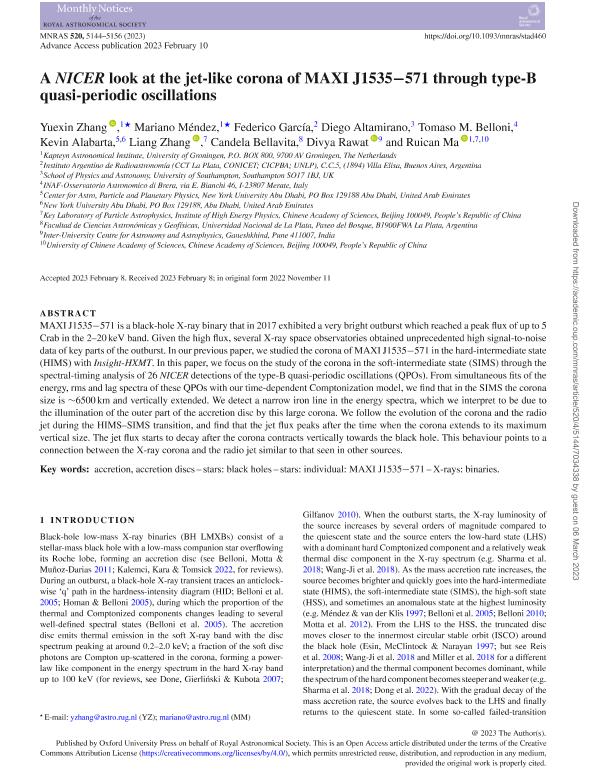Artículo
A NICER look at the jet-like corona of MAXI J1535−571 through type-B quasi-periodic oscillations
Zhang, Yuexin; Méndez, Mariano; García, Federico ; Altamirano, Diego; Belloni, Tomaso M.; Alabarta, Kevin; Zhang, Liang; Bellavita, Candela Abril
; Altamirano, Diego; Belloni, Tomaso M.; Alabarta, Kevin; Zhang, Liang; Bellavita, Candela Abril ; Rawat, Divya; Ma, Ruican
; Rawat, Divya; Ma, Ruican
 ; Altamirano, Diego; Belloni, Tomaso M.; Alabarta, Kevin; Zhang, Liang; Bellavita, Candela Abril
; Altamirano, Diego; Belloni, Tomaso M.; Alabarta, Kevin; Zhang, Liang; Bellavita, Candela Abril ; Rawat, Divya; Ma, Ruican
; Rawat, Divya; Ma, Ruican
Fecha de publicación:
04/2023
Editorial:
Wiley Blackwell Publishing, Inc
Revista:
Monthly Notices of the Royal Astronomical Society
ISSN:
0035-8711
Idioma:
Inglés
Tipo de recurso:
Artículo publicado
Clasificación temática:
Resumen
MAXI J1535-571 is a black-hole X-ray binary that in 2017 exhibited a very bright outburst which reached a peak flux of up to 5 Crab in the 2-20 keV band. Given the high flux, several X-ray space observatories obtained unprecedented high signal-to-noise data of key parts of the outburst. In our previous paper we studied the corona of MAXI J1535-571 in the hard-intermediate state (HIMS) with Insight-HXMT. In this paper we focus on the study of the corona in the soft-intermediate state (SIMS) through the spectral-timing analysis of 26 NICER detections of the type-B quasi-periodic oscillations (QPOs). From simultaneous fits of the energy, rms and lag spectra of these QPOs with our time-dependent Comptonization model, we find that in the SIMS the corona size is ~ 6500 km and vertically extended. We detect a narrow iron line in the energy spectra, which we interpret to be due to the illumination of the outer part of the accretion disk by this large corona. We follow the evolution of the corona and the radio jet during the HIMS-SIMS transition, and find that the jet flux peaks after the time when the corona extends to its maximum vertical size. The jet flux starts to decay after the corona contracts vertically towards the black hole. This behavior points to a connection between the X-ray corona and the radio jet similar to that seen in other sources.
Archivos asociados
Licencia
Identificadores
Colecciones
Articulos(IAR)
Articulos de INST.ARG.DE RADIOASTRONOMIA (I)
Articulos de INST.ARG.DE RADIOASTRONOMIA (I)
Citación
Zhang, Yuexin; Méndez, Mariano; García, Federico; Altamirano, Diego; Belloni, Tomaso M.; et al.; A NICER look at the jet-like corona of MAXI J1535−571 through type-B quasi-periodic oscillations; Wiley Blackwell Publishing, Inc; Monthly Notices of the Royal Astronomical Society; 520; 4; 4-2023; 5144-5156
Compartir
Altmétricas



